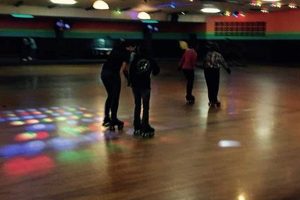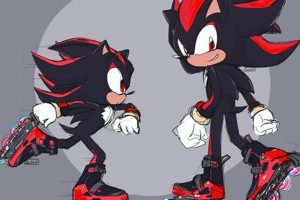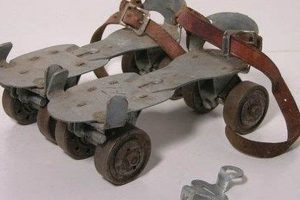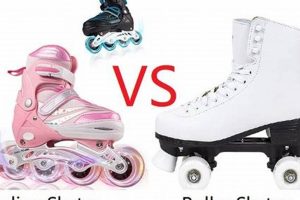High-performance quad or inline skates designed for advanced users represent a significant investment in skating proficiency. These models typically incorporate superior materials, precision engineering, and customized fit options to optimize performance. Examples include skates featuring lightweight carbon fiber boots, high rebound wheels, and adjustable frames, catering to disciplines like roller derby, artistic skating, and speed skating.
The employment of such specialized equipment can lead to improved control, enhanced speed, and reduced fatigue during prolonged use. Historically, advancements in skating technology have consistently pushed the boundaries of athletic achievement. Benefits extend to increased agility and responsiveness, contributing to a competitive edge in various skating pursuits. The use of durable construction ensures that such an investment can withstand rigorous use, offering reliable performance over time.
A comprehensive understanding of the component specifications, customization possibilities, and maintenance requirements is essential for maximizing the advantages offered by specialized skating equipment. Further exploration will delve into selecting the appropriate wheel durometer, frame alignment, and bearing types, all of which affect the user experience.
Enhancing Performance with Specialized Skating Equipment
The following guidelines are intended to assist users in optimizing the performance and longevity of high-performance skating equipment. Adherence to these recommendations will contribute to a more efficient and enjoyable skating experience.
Tip 1: Wheel Selection: Evaluate wheel durometer based on skating surface. Harder wheels are appropriate for smooth surfaces, providing increased speed and reduced rolling resistance. Softer wheels offer superior grip on rougher surfaces. Regular rotation extends wheel life and maintains consistent performance.
Tip 2: Bearing Maintenance: Clean bearings regularly using appropriate solvents to remove dirt and debris. Lubricate with a thin oil specifically designed for bearings. Replace bearings exhibiting excessive wear or noise to maintain optimal rolling efficiency.
Tip 3: Frame Alignment: Ensure proper frame alignment to prevent uneven wear and improve stability. Misalignment can lead to reduced speed and increased effort. Consult with a qualified technician for frame adjustments.
Tip 4: Boot Fit: Secure and comfortable boot fit is crucial for maximizing power transfer and minimizing fatigue. Custom molding or heat forming may be necessary to achieve optimal fit. Replace worn liners to maintain support and comfort.
Tip 5: Protective Gear: Consistent use of appropriate protective gear, including helmets, knee pads, elbow pads, and wrist guards, is essential for mitigating injury risk. Ensure that gear fits properly and meets safety standards.
Tip 6: Training Regimen: Implement a structured training regimen that incorporates both on-skate and off-skate exercises. Focus on developing strength, agility, and endurance to improve overall performance.
Tip 7: Regular Inspection: Conduct regular inspections of all components, including boots, frames, wheels, and bearings, to identify potential problems early. Address issues promptly to prevent further damage and maintain safety.
The proper selection, maintenance, and utilization of specialized skating equipment directly impact performance, safety, and longevity. Consistent adherence to these guidelines will contribute to a more rewarding skating experience.
The following sections will delve into specific equipment types and their applications.
1. Precision Engineering
Precision engineering represents a foundational element in the design and manufacturing of high-performance skating equipment. Its influence extends from the selection of materials to the assembly of components, directly impacting performance characteristics and overall durability.
- Bearing Tolerance
Bearing tolerance refers to the allowable variation in the dimensions of the bearing components. Tighter tolerances result in smoother, faster, and more efficient rolling. High-performance skates utilize ABEC-7 or higher rated bearings with micron-level tolerances, minimizing friction and maximizing speed potential. Incorrectly toleranced bearings can cause vibrations and reduced efficiency.
- Frame Alignment
Frame alignment dictates the relationship between the wheels and the skater’s center of gravity. Precisely aligned frames ensure consistent power transfer and optimal handling. Misalignment can cause instability and uneven wheel wear. Frames are typically CNC-machined from high-strength aluminum alloys to maintain precise alignment under stress.
- Boot Construction
The boot’s construction integrates advanced materials, such as carbon fiber or fiberglass composites, to provide a rigid and supportive structure. Precision molding techniques ensure a snug and anatomically correct fit, optimizing power transfer and reducing energy loss. Poorly constructed boots can lead to discomfort and reduced control.
- Wheel Durometer Consistency
Wheel durometer refers to the hardness of the wheel. Maintaining consistent durometer across all wheels ensures predictable grip and roll characteristics. Precision manufacturing processes minimize durometer variations, resulting in a smoother and more controlled skating experience. Inconsistent durometer can lead to uneven wear and unpredictable handling.
The integration of precision engineering principles directly translates into enhanced performance, improved control, and increased durability in high-performance skating equipment. Through careful selection and implementation of advanced manufacturing techniques, professional skaters can achieve a competitive edge and maximize their potential.
2. Material Composition
The selection and utilization of materials in the construction of high-performance skating equipment significantly impacts performance characteristics, durability, and overall user experience. These components determine the skate’s weight, responsiveness, and ability to withstand the stresses of competitive use.
- Boot Materials
Boot construction often involves carbon fiber, fiberglass composites, or advanced polymers. Carbon fiber boots offer exceptional stiffness-to-weight ratios, maximizing energy transfer during skating. Fiberglass composites provide a balance of stiffness and comfort, while advanced polymers offer durability and impact resistance. The choice of boot material influences the skate’s overall weight and responsiveness.
- Frame Materials
Frames are typically constructed from high-strength aluminum alloys or carbon fiber. Aluminum frames provide excellent durability and stiffness for efficient power transfer. Carbon fiber frames offer further weight reduction, enhancing agility and speed. Frame material influences the skate’s responsiveness and ability to withstand the forces generated during skating maneuvers.
- Wheel Materials
Wheels consist of polyurethane (PU) compounds, with varying durometers (hardness) and rebound characteristics. High-rebound PU compounds provide superior roll speed and grip, optimizing performance. Wheel durometer influences the skate’s speed, grip, and wear resistance. Advanced formulations may incorporate additives to enhance grip or durability.
- Bearing Materials
Bearings typically utilize hardened steel or ceramic balls within a steel or nylon cage. Ceramic bearings offer lower friction and increased durability compared to steel bearings, resulting in higher speeds. Bearing materials and construction influence the skate’s rolling efficiency and overall performance.
The selection of appropriate materials for each component contributes to a cohesive system that optimizes performance, durability, and user satisfaction. The synergy between boot, frame, wheels, and bearings is crucial for achieving peak performance in competitive skating.
3. Customized Fit
The integration of a customized fit within high-performance skating equipment directly influences an athlete’s ability to translate power efficiently and maintain control. The connection between a personalized fit and enhanced performance stems from the improved proprioception and reduced risk of discomfort or injury. Improper fit can lead to blisters, pressure points, and compromised stability, negating the advantages of high-end components. For example, a skater in a speed discipline requires a snug, molded boot to minimize energy loss during each stride, directly translating to faster lap times. A boot that allows foot movement absorbs energy and decreases efficiency.
The process of achieving a customized fit often involves heat molding, where the boot’s shell is softened and shaped to the individual’s foot contours. Custom insoles provide arch support and correct biomechanical imbalances, further enhancing comfort and efficiency. Moreover, the ability to adjust the frame’s position relative to the boot allows skaters to fine-tune the skate’s handling characteristics to their specific skating style. An aggressive skater may adjust the frame to improve balance and maneuverability in a skate park.
Ultimately, customized fit is an indispensable component of high-performance skating equipment, as it ensures optimal power transfer, reduces the risk of injury, and enhances overall performance. Ignoring fit compromises even the most advanced componentry. Prioritizing a properly fitted skate allows athletes to harness the full potential of their equipment and achieve peak performance levels. The challenge lies in accessing skilled technicians and specialized fitting equipment, factors that can increase the initial investment but yield significant long-term benefits.
4. Performance Enhancement
The integration of performance enhancement features within professional-grade roller skates is a critical determinant of an athlete’s ability to achieve competitive success. Optimized components and design characteristics translate directly into measurable improvements in speed, agility, and overall efficiency on the skating surface. The following facets explore specific elements that contribute to this enhancement.
- Aerodynamic Efficiency
Minimizing air resistance is paramount in disciplines such as speed skating. Boot designs that streamline airflow around the skater’s legs, combined with close-fitting apparel, reduce drag and increase velocity. For instance, wind tunnel testing informs the shape and materials used in professional speed skates, ensuring that even minor reductions in drag translate to significant time savings over race distances.
- Energy Transfer Optimization
Efficient transmission of power from the skater’s muscles to the wheels is vital for maximizing acceleration and maintaining speed. Stiff boot constructions, coupled with responsive frame designs, minimize energy loss during each stride. Professional figure skates, for example, utilize reinforced soles and precision-mounted blades to ensure direct transfer of energy during jumps and spins.
- Rolling Resistance Reduction
Minimizing the friction between wheels and the skating surface enhances roll speed and reduces fatigue. High-performance wheels with low rolling resistance are engineered from specialized polyurethane compounds. Precision bearings further minimize friction within the wheel assembly. Speed skaters select wheel durometers (hardness) based on track conditions, optimizing grip and roll for each event.
- Ankle Support and Stability
Providing adequate ankle support and stability is crucial for preventing injuries and maximizing control, particularly during demanding maneuvers. High-cut boot designs and reinforced ankle supports limit lateral movement, enhancing stability during turns and jumps. Artistic skaters require boots that offer both support and flexibility, enabling them to execute complex routines with precision and control.
The synergistic combination of these performance-enhancing elements defines the capabilities of professional roller skates. The selection of appropriate components and design features is dependent on the specific skating discipline and the athlete’s individual needs, highlighting the importance of specialized equipment for achieving peak performance.
5. Maintenance Protocols
The operational lifespan and performance consistency of professional roller skates are inextricably linked to adherence to rigorous maintenance protocols. The sophisticated engineering and specialized materials employed in their construction necessitate diligent upkeep to prevent degradation and ensure optimal functionality. Failure to implement proper maintenance can lead to diminished performance, accelerated component wear, and potential safety hazards.
The efficacy of maintenance protocols is demonstrably evident in various skating disciplines. For example, in roller derby, skates are subjected to high-impact forces and abrasive surfaces. Routine maintenance, including bearing cleaning and lubrication, wheel rotation, and frame inspection, is critical for maintaining maneuverability and preventing equipment failure during competition. Similarly, in artistic skating, precision wheel alignment and boot maintenance are essential for executing intricate routines with accuracy and control. Furthermore, proactive component replacement, such as worn-out wheels or damaged bearings, is crucial for mitigating the risk of accidents or performance degradation. Regularly inspecting and cleaning the boots themselves can prevent material breakdown, prolonging their lifespan.
In summation, systematic maintenance is not merely an ancillary task but an integral component of owning professional roller skates. This proactive approach ensures the continued functionality of specialized equipment and preserves the skater’s investment. By prioritizing the implementation of consistent maintenance routines, individuals can maximize the operational lifespan of their skates, optimize performance, and mitigate the potential for safety-related incidents. The direct correlation between meticulous upkeep and sustained performance underscores the practical significance of adopting and adhering to comprehensive maintenance schedules.
Frequently Asked Questions
The following questions address common inquiries and misconceptions regarding high-performance roller skates, offering clarity and insight into their selection, maintenance, and optimal use.
Question 1: What distinguishes professional roller skates from recreational models?
Professional roller skates exhibit superior construction, employing advanced materials such as carbon fiber and high-rebound polyurethane. Enhanced precision in engineering, coupled with customization options, contribute to optimized performance and durability, factors often absent in recreational-grade equipment.
Question 2: How frequently should professional roller skate bearings be cleaned and lubricated?
Bearing maintenance frequency depends on usage intensity and environmental conditions. Generally, cleaning and lubrication every 10-20 hours of use is recommended. However, exposure to dirt, moisture, or abrasive surfaces necessitates more frequent maintenance to prevent premature wear and maintain optimal rolling efficiency.
Question 3: What is the significance of wheel durometer in relation to skating surface?
Wheel durometer, a measure of hardness, significantly impacts grip and roll characteristics. Harder wheels (higher durometer) are suitable for smooth surfaces, offering increased speed and reduced rolling resistance. Softer wheels (lower durometer) provide enhanced grip on rougher surfaces, improving control and maneuverability.
Question 4: How does frame alignment influence roller skate performance?
Proper frame alignment ensures consistent power transfer and optimal handling. Misalignment can lead to uneven wheel wear, reduced speed, and instability. Periodic frame checks and adjustments by a qualified technician are recommended to maintain optimal performance and prevent premature component wear.
Question 5: What are the key considerations when selecting a professional roller skate boot?
Boot selection should prioritize fit, support, and material composition. A snug and comfortable fit is crucial for maximizing power transfer and minimizing fatigue. Ankle support is essential for stability and injury prevention. Carbon fiber or fiberglass composites offer optimal stiffness-to-weight ratios for enhanced responsiveness.
Question 6: How can the lifespan of professional roller skate wheels be maximized?
Regular wheel rotation, based on wear patterns, is essential for maximizing wheel lifespan. Switching wheel positions distributes wear evenly, extending the overall usability of the set. Additionally, avoiding abrasive surfaces and excessive braking can further prolong wheel life.
In summary, diligent maintenance, informed component selection, and a thorough understanding of equipment characteristics are paramount for maximizing the performance and longevity of professional roller skates.
The next segment will explore the economic considerations associated with acquiring and maintaining high-performance skating equipment.
Pro Roller Skates
The preceding exploration has underscored the multifaceted nature of pro roller skates, emphasizing the significance of precision engineering, advanced material composition, customized fit, performance enhancement features, and rigorous maintenance protocols. These elements, when harmoniously integrated, culminate in equipment that facilitates peak athletic performance and longevity. The selection and proper utilization of these skates require a comprehensive understanding of the factors outlined, allowing athletes to maximize their investment and achieve competitive success.
The pursuit of optimal performance through specialized skating equipment represents a continuing evolution. Further research and technological advancements will undoubtedly yield even greater refinements in design and materials, pushing the boundaries of what is achievable on the skating surface. Individuals and organizations committed to advancing the sport must prioritize ongoing education and collaboration to ensure that athletes have access to the tools and knowledge necessary to reach their full potential.





![Choosing: Rollerblades or Roller Skates Guide [2024] Safem Fabrication - Precision Engineering & Custom Manufacturing Solutions Choosing: Rollerblades or Roller Skates Guide [2024] | Safem Fabrication - Precision Engineering & Custom Manufacturing Solutions](https://cruzskateshop.com/wp-content/uploads/2025/06/th-3338-300x200.jpg)

